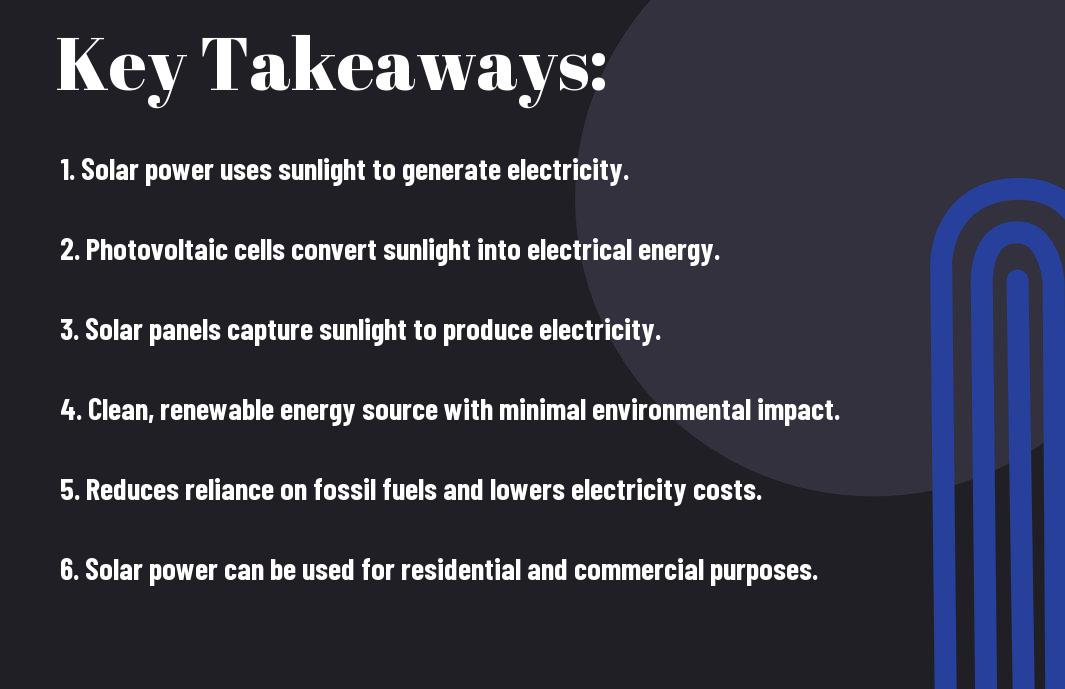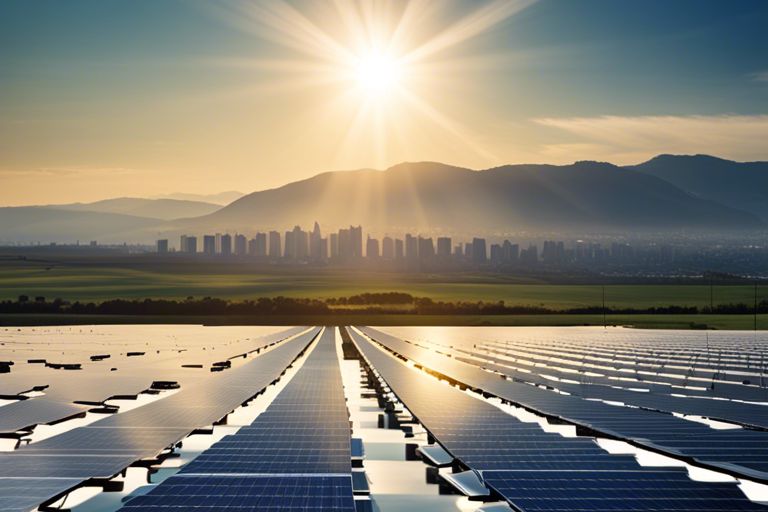Over the past few decades, advancements in technology have made solar power an increasingly popular and accessible source of renewable energy. Solar powered electricity is obtained through the conversion of sunlight into electrical energy using photovoltaic panels. When sunlight hits these panels, it creates an electric current that can be used to power your home, car, or even an entire city. By harnessing the power of the sun, you can reduce your carbon footprint and contribute to a more sustainable future for our planet. Let’s investigate the fascinating world of solar power and discover how it can revolutionize the way we power our world.
Key Takeaways:
- Solar power is electricity generated from sunlight using photovoltaic panels or solar thermal systems.
- Photovoltaic panels convert sunlight directly into electricity using semiconducting materials.
- Solar thermal systems use sunlight to heat a fluid, which produces steam to drive a turbine and generate electricity.
- Solar power is a renewable energy source that is clean, sustainable, and reduces greenhouse gas emissions.
- Solar powered electricity can be used for residential, commercial, and industrial applications to offset energy costs and reduce dependence on traditional fossil fuels.


Definition
What is Solar Power
For centuries, humans have harnessed the power of the sun to generate electricity. Solar power, also known as solar energy, is the conversion of sunlight into electricity using photovoltaic panels. These panels contain cells that absorb sunlight and convert it into usable electricity through a process called the photovoltaic effect. This renewable energy source is not only environmentally friendly but also plays a crucial role in reducing our dependence on non-renewable resources.
What is Electricity
The concept of electricity can be complex, but at its core, it is the flow of electrical power or charge. When you plug in a device or turn on a light switch, you are allowing the flow of electrons through a conductor, such as a wire. This movement of electrons creates an electric current that powers our homes, businesses, and technology. In the case of solar power, sunlight is converted into electricity, providing a clean and sustainable energy source.
Understanding Electricity: In everyday life, electricity is an crucial part of modern society. It powers our appliances, charges our devices, and lights up our homes. Understanding how electricity is generated and used can help you appreciate the importance of renewable energy sources like solar power in creating a more sustainable future for our planet.
How it Works
It can be fascinating to understand the technology behind solar power generation. If you want to research deeper into the scientific aspects, you can explore Solar Energy Basics for a comprehensive overview.
Photovoltaic Cells
For the process to begin, photovoltaic cells are crucial. These cells, made of semiconductor materials like silicon, absorb sunlight and cause electrons to flow, generating a direct current (DC) of electricity when exposed to light.
Converting Sunlight into Energy
An intricate system then converts the DC electricity produced by the photovoltaic cells into alternating current (AC) electricity, which is what powers your home. This conversion is achieved through the use of inverters.
Another vital component in this setup is the grid connection. Once the electricity is converted into AC, it flows through the grid connection, allowing you to use the generated solar power alongside traditional electricity sources.
Inverters and Grid Connection
Sunlight is converted into electrical energy by the photovoltaic cells. Inverters play a critical role in transforming this energy into a usable form for your home appliances, ensuring a seamless integration of solar power into your daily life.
Converting sunlight into usable electricity involves a sophisticated process that has been optimized over the years to make solar power a reliable and sustainable source of energy for countless households and businesses.
Benefits
Renewable Energy Source
An important benefit of solar powered electricity is that it comes from a renewable energy source. This means that the sunlight used to generate electricity will never run out. As long as the sun continues to shine, you can harness its power to generate clean and sustainable electricity for your home or business.
Zero Emissions
With solar powered electricity, you can enjoy the benefit of zero emissions. Unlike traditional fossil fuel power plants that release harmful greenhouse gases into the atmosphere, solar power systems produce electricity without any emissions. This helps reduce your carbon footprint and contributes to a cleaner environment.
Understanding the importance of zero emissions is crucial in combating climate change. By choosing solar powered electricity, you are helping to reduce air pollution and protect the planet for future generations. Your decision to go solar can make a significant impact on the environment and promote a more sustainable way of living.
Energy Independence
Energy independence is another key benefit of solar powered electricity. By generating your own electricity from the sun, you can reduce your reliance on the grid and take control of your energy needs. This can lead to greater stability and security, especially during times of power outages or fluctuations in energy prices.

Types of Solar Powered Electricity
After learning about solar powered electricity, it’s important to understand the different types available. Here are the main types of solar-powered electricity systems to consider:
- Residential Systems
- Commercial Systems
- Industrial Systems
| Residential Systems | Commercial Systems |
| Commercial Systems | Industrial Systems |
| Industrial Systems |
Residential Systems
With residential systems, you can generate solar-powered electricity for your home. These systems typically include solar panels installed on your roof or in your yard. The solar panels collect sunlight and convert it into electricity that can power your household appliances. You can also connect these systems to the grid to sell excess electricity back to your utility company.
Commercial Systems
For commercial systems, businesses can install solar panels on their buildings or properties to generate electricity. This can help reduce energy costs for the business and also demonstrate a commitment to sustainability. Commercial solar power systems can be scaled up to meet the energy demands of larger operations, providing a reliable source of electricity.
Commercial buildings often have more available roof space for solar panels, allowing for larger systems to be installed. This can lead to significant cost savings and environmental benefits for businesses that choose to invest in solar power.
Industrial Systems
Commercial and industrial systems are designed to meet the high energy demands of large-scale operations such as factories, warehouses, and manufacturing facilities. These systems often require a larger number of solar panels and more complex installation processes to generate the necessary amount of electricity.
Commercial and industrial solar power systems can help reduce operational costs and reliance on traditional energy sources. By harnessing the power of the sun, these systems provide a sustainable and environmentally friendly energy solution for industrial operations.
The key to choosing the right solar-powered electricity system for your needs is to consider the size of the installation, energy demands, and available space for solar panels. Whether you are looking to power your home, business, or industrial facility, solar energy offers a clean and renewable alternative to traditional electricity sources.
Challenges
Intermittent Energy Source
One challenge of solar power is that it is an intermittent energy source. This means that the amount of electricity generated by solar panels can vary depending on factors such as weather conditions and time of day. During the night or on cloudy days, the amount of electricity produced by solar panels decreases, which can be a limitation if you require a consistent and reliable energy supply.
High Upfront Costs
One challenge you may face when considering solar power is the high upfront costs associated with installing solar panels and the necessary equipment to convert sunlight into electricity. While solar power can lead to long-term savings on your electricity bills, the initial investment required for solar panel installation can be a barrier for some people.
Another consideration when it comes to high upfront costs is the return on investment. While solar panels can eventually pay for themselves through energy savings, it may take several years to recoup the initial investment. This long payback period can be a deterrent for some individuals looking to transition to solar power.
Energy Storage Limitations
High energy storage limitations can also pose a challenge when it comes to solar power. While solar panels can generate electricity during the day, you may not always be able to use all the electricity produced in real-time. This excess energy needs to be stored for use during periods when solar panels are not actively generating electricity, such as at night. Current energy storage technologies, such as batteries, may have limitations in terms of capacity and efficiency, which can impact the overall reliability of a solar power system.
Understanding energy storage limitations is crucial when considering solar power for your energy needs. While advancements in energy storage technologies are continuously being made, it’s vital to evaluate your energy usage patterns and storage requirements to ensure that a solar power system can meet your specific needs.
Advancements
Unlike The Advantages and Disadvantages of Solar Energy, solar power technology has seen significant advancements in recent years. One major area of improvement has been the increased efficiency in solar panels.
Increased Efficiency in Solar Panels
With ongoing research and development, solar panels have become more efficient at converting sunlight into electricity. This means that a smaller area of panels can now produce the same amount of power as larger, older models. These advancements have made solar energy a more viable and attractive option for homeowners and businesses looking to reduce their carbon footprint and save on energy costs.
Decreasing Costs of Solar Energy
Costs associated with solar energy have been steadily decreasing, making it a more accessible and affordable renewable energy source for many. The initial investment in solar panels and installation can now be recovered in a shorter period due to these lower costs. Additionally, government incentives and rebates are often available to further reduce the upfront expenses of going solar.
This overall decrease in costs has made solar energy a financially appealing option for both residential and commercial applications. As technology continues to advance, we can expect these costs to decrease even further, driving the widespread adoption of solar power.
Emerging Technologies in Energy Storage
Decreasing the reliance on traditional energy sources, emerging technologies in energy storage are revolutionizing the way we harness and use solar power. Energy storage systems, such as batteries, can store excess energy generated by solar panels during the day for use at night or on cloudy days. This allows for a more consistent and reliable power supply from solar energy, regardless of environmental conditions or time of day.
This innovative approach to energy storage is key to the continued growth and sustainability of solar power. With advancements in battery technology and other storage solutions, we are moving closer to a future where renewable energy sources like solar can fully replace fossil fuels in our energy production.
Conclusion
Drawing together all the information presented in this article, you now have a better understanding of what solar powered electricity is and how it works. Solar power, also known as solar energy, harnesses the radiant light and heat from the sun to generate electricity through photovoltaic cells. This renewable energy source is sustainable and environmentally friendly, making it a key player in the shift towards cleaner sources of power.
By utilizing solar power, you can reduce your carbon footprint and contribute to a more sustainable future. If you’re interested in learning more about solar power and its benefits, you can explore further information on Solar power. Incorporating solar technology into your home or business can not only save you money on energy bills but also help mitigate the impact of climate change. Embracing solar powered electricity is a step towards a brighter and greener tomorrow.
FAQ
Q: What is solar powered electricity?
A: Solar powered electricity, also known as solar energy, is generated by capturing sunlight using photovoltaic (PV) cells, which convert sunlight directly into electricity. This renewable energy source is used to power homes, businesses, and other electrical devices.
Q: How does solar powered electricity work?
A: Solar panels are installed on rooftops or in open areas, where they absorb sunlight and convert it into direct current (DC) electricity. An inverter then converts the DC electricity into alternating current (AC) electricity, which can be used to power electrical devices and appliances.
Q: What are the benefits of using solar powered electricity?
A: Some of the benefits of using solar powered electricity include: reducing electricity bills, decreasing reliance on fossil fuels, lowering carbon footprint, increasing energy independence, and contributing to a cleaner environment by reducing greenhouse gas emissions.
